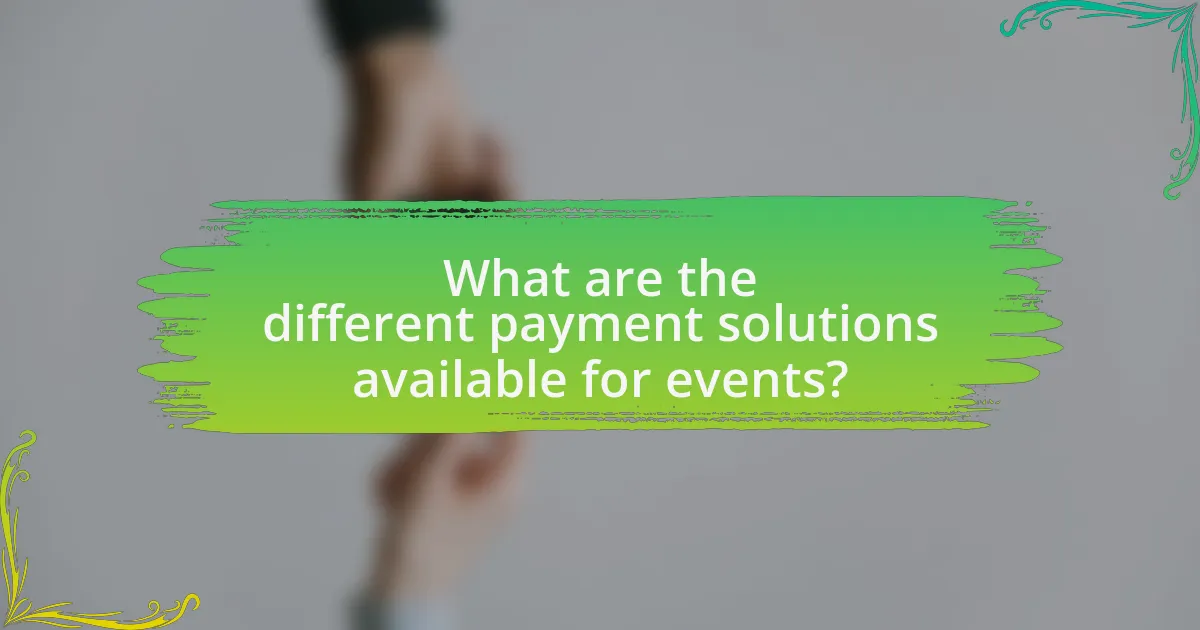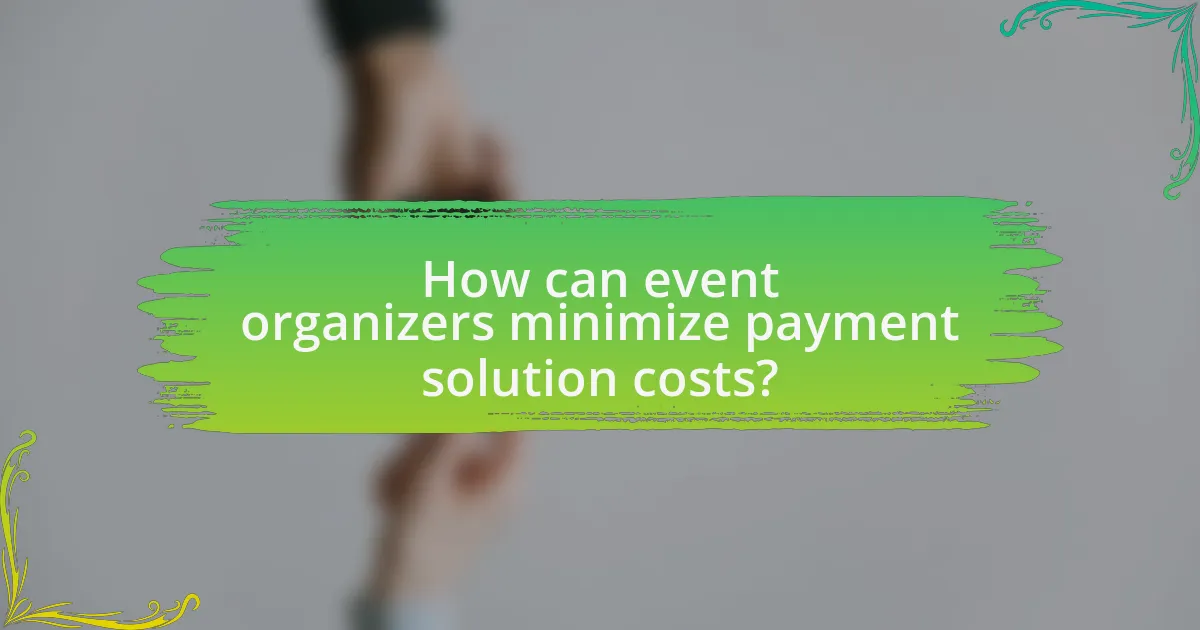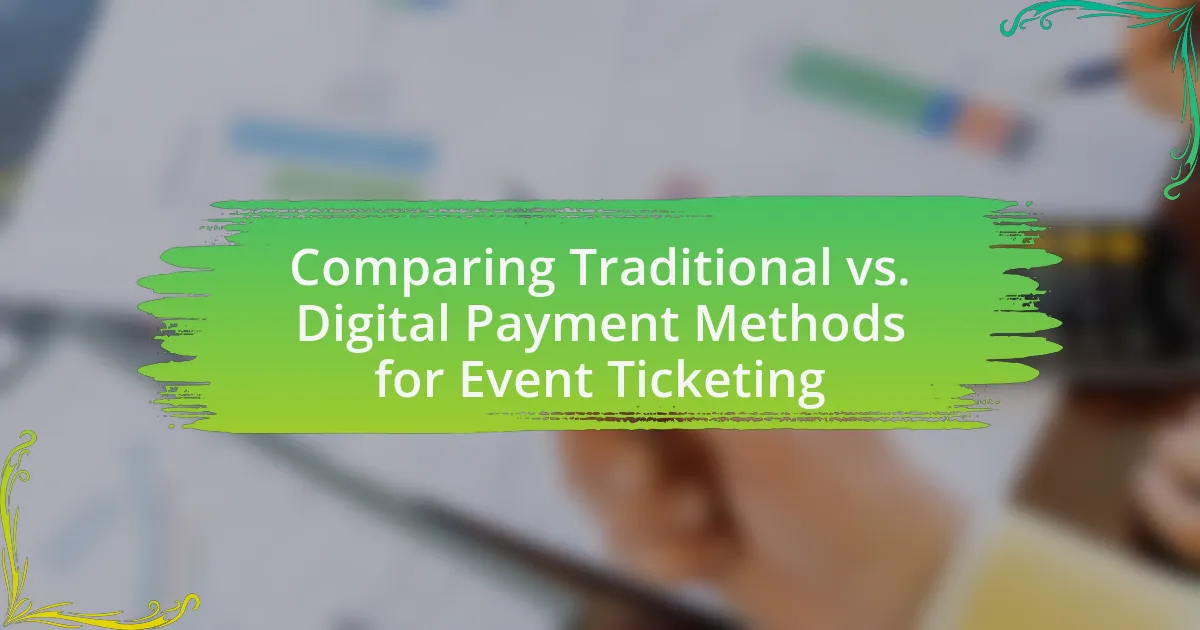The article focuses on analyzing the costs associated with various payment solutions for events, including credit card processing, mobile payment systems, online payment gateways, and cash transactions. It compares traditional payment methods with modern solutions, detailing the fee structures and implications of each. Key topics include the impact of transaction volumes on fees, the advantages of digital wallets, and strategies for minimizing payment solution costs. Additionally, the article highlights the importance of understanding fee structures, negotiating better terms, and avoiding common pitfalls to effectively manage payment processing expenses for event organizers.
What are the different payment solutions available for events?

Different payment solutions available for events include credit card processing, mobile payment systems, online payment gateways, and cash transactions. Credit card processing allows attendees to pay using their credit or debit cards, often facilitated by point-of-sale systems. Mobile payment systems, such as Apple Pay and Google Pay, enable quick transactions via smartphones. Online payment gateways, like PayPal and Stripe, provide a platform for attendees to purchase tickets or register for events online. Cash transactions remain a traditional method, allowing immediate payment at the event. Each solution has its own fee structure, impacting the overall cost of event management.
How do traditional payment methods compare to modern solutions?
Traditional payment methods, such as cash and checks, generally incur lower transaction fees compared to modern solutions like credit cards and digital wallets. Traditional methods often have no processing fees, while modern solutions can charge fees ranging from 1.5% to 3.5% per transaction, depending on the provider. For example, credit card companies typically charge merchants a percentage of the transaction amount, which can significantly increase costs for event organizers. Additionally, modern solutions offer convenience and speed, which can enhance customer experience but may come at a higher price point.
What are the fees associated with credit card payments?
Credit card payments typically incur several fees, including transaction fees, processing fees, and interchange fees. Transaction fees are charged by payment processors for each transaction, often ranging from 1.5% to 3.5% of the transaction amount. Processing fees cover the costs of handling the payment and can be a flat fee or a percentage of the sale. Interchange fees are set by credit card networks and are paid to the card-issuing bank, generally varying between 1% and 2.5%. These fees can significantly impact the overall cost of accepting credit card payments for events.
How do bank transfers impact event budgeting?
Bank transfers impact event budgeting by influencing cash flow management and incurring transaction fees. When funds are transferred electronically, the timing of these transfers can affect when event organizers have access to necessary capital, potentially delaying payments to vendors or affecting the ability to secure venues. Additionally, many banks charge fees for processing transfers, which can reduce the overall budget available for event expenses. For instance, a study by the National Association of Professional Event Planners found that transaction fees can range from 1% to 3% of the total amount transferred, which can significantly impact smaller event budgets.
What are the advantages of using digital wallets for event payments?
Digital wallets offer several advantages for event payments, including convenience, speed, and enhanced security. Users can make transactions quickly without the need for cash or physical cards, streamlining the payment process during events. Additionally, digital wallets often incorporate advanced security features such as encryption and biometric authentication, reducing the risk of fraud. According to a study by Statista, the global digital wallet market is projected to reach $7.5 trillion by 2024, indicating a growing preference for this payment method among consumers. This trend highlights the increasing trust and reliance on digital wallets for secure and efficient transactions in various settings, including events.
How do transaction fees for digital wallets vary?
Transaction fees for digital wallets vary based on several factors, including the payment processor, transaction volume, and the type of transaction. For instance, some digital wallets charge a flat fee per transaction, while others may take a percentage of the transaction amount, which can range from 1% to 3%. Additionally, fees may differ for domestic versus international transactions, with international fees often being higher due to currency conversion costs. According to a 2022 report by the Federal Reserve, the average transaction fee for digital wallets in the U.S. was approximately 2.5%, highlighting the variability in costs associated with different providers and transaction types.
What security features do digital wallets offer?
Digital wallets offer several security features, including encryption, two-factor authentication, and biometric verification. Encryption protects sensitive data by converting it into a secure format that can only be accessed with the correct decryption key. Two-factor authentication adds an extra layer of security by requiring users to provide two forms of identification before accessing their wallet. Biometric verification, such as fingerprint or facial recognition, ensures that only authorized users can access the wallet. These features collectively enhance the security of digital wallets, making them a safer option for transactions.
What factors influence the fees of payment solutions for events?

The fees of payment solutions for events are influenced by transaction volume, payment method, service provider fees, and additional features. Transaction volume affects fees because higher volumes often lead to lower per-transaction costs due to economies of scale. Payment methods, such as credit cards, digital wallets, or bank transfers, can have varying fee structures, with credit card transactions typically incurring higher fees. Service provider fees vary based on the provider’s pricing model, which may include flat fees, percentage-based fees, or a combination of both. Additional features, such as fraud protection, customer support, and integration capabilities, can also contribute to the overall cost, as providers may charge extra for these services.
How do transaction volumes affect payment processing fees?
Transaction volumes directly influence payment processing fees, as higher volumes typically lead to lower per-transaction costs. Payment processors often offer tiered pricing structures where businesses that process a larger number of transactions benefit from reduced rates due to economies of scale. For instance, a business processing $100,000 in transactions may incur a lower percentage fee compared to a business processing only $10,000, as the fixed costs of processing are spread over a larger number of transactions. This pricing model is supported by industry data, which shows that businesses with higher transaction volumes can negotiate better rates, resulting in significant savings on processing fees.
What is the relationship between transaction size and fees?
Transaction size directly influences fees, as larger transactions typically incur higher fees due to the percentage-based fee structures commonly used by payment processors. For instance, many payment processors charge a fee that is a percentage of the transaction amount, meaning that as the transaction size increases, the total fee also increases. Additionally, fixed fees may apply, which can further amplify the cost for larger transactions. This relationship is evident in various payment solutions, where fees can range from 2% to 5% of the transaction amount, depending on the provider and the size of the transaction.
How do payment processors determine their fee structures?
Payment processors determine their fee structures based on several factors, including transaction volume, risk assessment, and the type of payment method used. Transaction volume influences fees because higher volumes often lead to lower per-transaction costs due to economies of scale. Risk assessment involves evaluating the likelihood of fraud or chargebacks, which can lead to higher fees for businesses deemed higher risk. Additionally, different payment methods, such as credit cards, debit cards, or digital wallets, have varying costs associated with processing, which also affects the overall fee structure. These factors collectively help payment processors establish competitive and sustainable pricing models.
What role do geographical locations play in payment solution fees?
Geographical locations significantly influence payment solution fees due to variations in regulatory environments, currency exchange rates, and local market conditions. For instance, payment processors may charge higher fees in regions with stringent compliance requirements or where fraud risk is elevated, as these factors necessitate additional security measures. Additionally, currency conversion fees can arise when transactions involve different currencies, impacting the overall cost for users in various locations. According to a report by the World Bank, cross-border payment fees can reach up to 7% in some regions, highlighting the financial impact of geographical factors on payment solutions.
How do international transactions impact costs?
International transactions increase costs primarily due to currency conversion fees, transaction fees, and potential tariffs. Currency conversion fees arise when payments are made in a different currency, often resulting in additional charges from banks or payment processors. Transaction fees can vary significantly based on the payment method used, with credit card companies typically charging higher fees for international transactions compared to domestic ones. Additionally, tariffs may apply to goods and services exchanged across borders, further inflating costs. According to a study by the World Bank, international remittance costs averaged 6.5% globally in 2020, highlighting the financial impact of these transactions.
What are the implications of currency conversion fees?
Currency conversion fees can significantly increase the overall cost of transactions involving different currencies. These fees typically range from 1% to 3% of the transaction amount, depending on the financial institution or payment provider. For example, if an event organizer is purchasing services from a vendor in another country, a currency conversion fee of 2% on a $1,000 transaction would add an additional $20 to the cost. This can impact budgeting and financial planning for events, as organizers must account for these extra expenses when calculating total costs. Additionally, frequent currency conversions can lead to cumulative fees, further straining budgets and potentially affecting the pricing of tickets or services offered at the event.
How can event organizers minimize payment solution costs?

Event organizers can minimize payment solution costs by negotiating lower transaction fees with payment processors. Many payment processors offer tiered pricing structures, and by discussing volume expectations or switching to a provider with lower fees, organizers can significantly reduce costs. For instance, a study by the National Association of Professional Event Planners found that organizations that negotiated fees saved an average of 15% on payment processing costs. Additionally, utilizing integrated payment solutions that streamline transactions can further decrease costs associated with multiple service providers.
What strategies can be employed to negotiate better fees?
To negotiate better fees, one effective strategy is to conduct thorough market research to understand the standard rates for similar services. This knowledge empowers individuals to present data-backed arguments during negotiations, demonstrating awareness of competitive pricing. For instance, a study by the Event Marketing Institute found that event planners who leverage industry benchmarks are 30% more likely to secure favorable terms. Additionally, building a strong relationship with service providers can lead to more flexible pricing options, as trust often encourages better deals.
How can bulk transaction agreements reduce costs?
Bulk transaction agreements can reduce costs by allowing organizations to negotiate lower fees based on the volume of transactions processed. When businesses commit to processing a large number of transactions, payment processors often provide discounted rates, which can significantly lower overall expenses. For instance, companies that engage in bulk agreements may see reductions in per-transaction fees, which can lead to savings of up to 20% or more compared to standard rates. This cost efficiency is particularly beneficial for events that anticipate high transaction volumes, as it directly impacts the bottom line by minimizing payment processing expenses.
What are the benefits of comparing multiple payment processors?
Comparing multiple payment processors allows businesses to identify the most cost-effective and suitable option for their specific needs. This process can lead to lower transaction fees, improved service features, and better integration with existing systems. For instance, a study by the Federal Reserve indicated that transaction fees can vary significantly among processors, with some charging as low as 1.5% while others may exceed 3%. Additionally, evaluating different processors can reveal unique features such as fraud protection, customer support, and reporting tools that can enhance operational efficiency. By analyzing these factors, businesses can make informed decisions that ultimately improve their financial performance and customer satisfaction.
What best practices should be followed when selecting a payment solution?
When selecting a payment solution, prioritize transparency in fees and terms. Clear understanding of transaction fees, monthly fees, and any hidden costs is essential for budgeting and financial planning. Research shows that businesses can save up to 30% by choosing payment solutions with straightforward pricing structures, as opposed to those with complex fee arrangements. Additionally, evaluate the solution’s compatibility with existing systems and its ability to handle various payment methods, as 70% of consumers prefer multiple payment options. Finally, consider customer support and security features, as 43% of businesses report that inadequate support negatively impacts their operations.
How can understanding fee structures lead to better decision-making?
Understanding fee structures enables individuals and organizations to make informed financial decisions regarding payment solutions for events. By analyzing the specific costs associated with different payment methods, decision-makers can identify the most cost-effective options, ultimately leading to better budgeting and resource allocation. For instance, a study by the National Association of Professional Event Planners found that organizations that thoroughly understood their fee structures saved an average of 15% on overall event costs. This understanding allows for strategic planning, ensuring that funds are utilized efficiently and that unexpected fees do not derail event budgets.
What common pitfalls should event organizers avoid regarding payment fees?
Event organizers should avoid underestimating transaction fees associated with payment solutions. Many organizers fail to account for the percentage fees charged by payment processors, which can significantly reduce profit margins. For instance, credit card processors typically charge between 2% to 3% per transaction, and additional fees may apply for international transactions or currency conversions. Additionally, organizers should be cautious of hidden fees, such as monthly service charges or fees for chargebacks, which can further impact overall costs. By thoroughly reviewing the fee structures of various payment providers, event organizers can make informed decisions that minimize unexpected expenses.
What are the key takeaways for managing payment solution costs effectively?
To manage payment solution costs effectively, businesses should analyze transaction fees, choose the right payment processor, and negotiate terms. Analyzing transaction fees involves understanding the structure of fees charged by different providers, which can vary significantly; for example, some may charge a flat rate while others may have tiered pricing based on transaction volume. Selecting the right payment processor is crucial, as providers like PayPal, Stripe, and Square offer different fee structures and services tailored to specific business needs. Additionally, negotiating terms with payment processors can lead to reduced fees, especially for businesses with high transaction volumes, as many providers are willing to offer discounts to retain customers.






